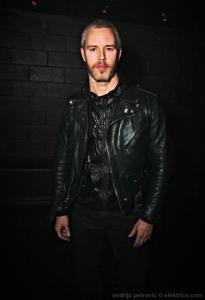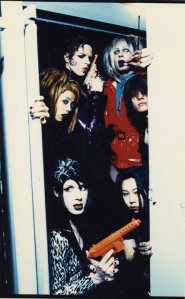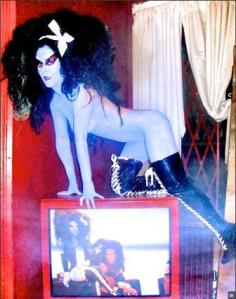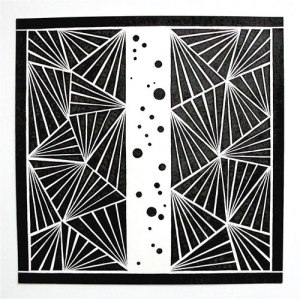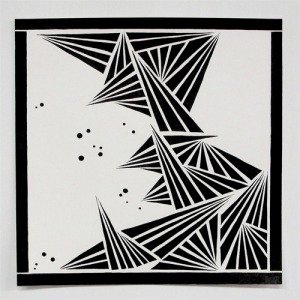Good evening ladies and gents!
I have something truly outrageous for you this evening, a coup and a half I can tell ya! One of my greatest inspirations recently agreed to Talk Toxic with me on this ‘ere blog – a man I’m sure you will all be familiar with; Nightlife legend, former club kid, front man of BOOB and artist of wonderous repute…. WALT CASSIDY aka WALT PAPER!!!!!!! I tell you I could have died when he agreed!
Focusing on array of topics including his days with seminal art-punk troupe and focus of Tuck and Cover issues 2 BOOB, as well as his continuing work as an artist exploring and utilising varying media, prepare yourselves as you sink your teeth into this latest edition of Talking Toxic! Enjoy…
Walt, your work as an artist has spanned almost three different lives and in doing so three different mediums that link and intertwine. You have stated previously that the divide between primitive and modern as well as the connections between psychology and mysticism, autobiography and methodology have carried great poignancy for you. How do you feel your work has progressed and how do perceive your growth as an artist?
I have always felt, since I was very young, that I was working on one continuous artwork….my life. The looks, objects and images that I have created and continue to create I consider to be residue of one master work, life. Someone once told me that my artwork felt “lived in”, which I took as a great compliment. This idea of occupancy, is something that is integral to my work. Occupancy operates on a very specific frequency, which requires constant tuning. My artworks are utilitarian, tools that I use for this type of tuning in my life.
Taking a step backwards, you were highly influential within the Club Scenes of the eighties and nineties as Walt Paper. Your work then seemed to focus on the artist as the object – a kind of Gunther Brus living spectacle utilising tribal imagery and contextualising this within modern urban environments. What inspired the creation of these images?
In the late 80’s, when I was in High School, I became involved with the Hardcore Punk and Industrial music scene in Virginia Beach. It provided me with a solid foundation of ethics from which I still operate to this day. Through that scene, I learned I could focus my creativity through community, street culture, the body, gender, and identity. All these things could be used as mediums, and I liked the way they operated in a public forum.
When I got to NYC in 1990, as an 18 year old art student, I was introduced to nightlife, and became involved with The Club Kids, many of whom I felt a great kinship. I was embraced and employed by the Peter Gatien empire of mega-clubs that dominated the city. It was very exciting, and reminiscent of the old Hollywood Studio system and Andy Warhol’s Factory. I felt supported, protected, and promoted on a much higher level.
I was also a student of African and Tribal Studies in college, which greatly informed my work. One professor who was of great influence on me, was Halim El Dahb, an Egyptian musician who had done musical scores for Martha Graham. I felt an affinity with the developing Modern Primitive movement, and was a great admirer of artists such as Ron Athey and the energy surrounding a body modification shop called Gauntlet that had opened in NYC.
As your creations evolved and you formed the wonderful Art-Punk group BOOB with Loxanna et al. your style changed again. What was the inspiration for this project? You have often said, as well did your bandmates, that you felt frustrated during this period because of a number of external factors effecting New York at the time – could you elaborate on this?
BOOB started amidst Rudy Giuliani’s “Quality of Life” campaign of the late 90’s which sought to sterilize NYC, and in the process eliminated most of Manhattan’s street and nightlife culture, by systematically closing all the prominent venues from Limelight to CBGB.
Having graduated, in many regards, from The Club Kids, we sought to focus our energy into a band. At the time, music was dominated by grunge, which was identity specific, but not especially flashy. With BOOB, we wanted to shift those aesthetics and present something that was much more theatrical and colorful. We also wanted to utilized the talent of our friends, and channel it into photography, films, costumes, and stage sets that accompanied our performances.
During the previously mentioned period, a number of similarities were drawn between yourself and Kembra Pfahler. How do you view Pfahler’s work and what is your current involvement with her?
I love Kembra, and have always been a great fan of her work. She is one of the great mentors of my life. Our bands performed together, and we also lived together for some time.
Kembra introduced me to great film. She is the person responsible for turning me on to Pasolini and Kenneth Anger. She also exposed me to Hermann Nitsch, Rudolf Schwarzkogler and the Vienna Actionists.
She single handedly taught me how to survive as an artist, introducing me to the notion that I didn’t have to self destruct in order to be creative.
Certainly even now there seems to be a hint of the DIY availabalist aesthetic to some of your creations – Although, in recent interviews you have mentioned the possession of energies by objects previously owned had become a hindrance to your process – what do you mean by this?
I love the Availablist component of Kembra’s work. I don’t see my work as Availabist, because I only initially used found objects in my first photo series, Kitchen Spells.
After doing that series, I felt that the energy attached to found objects dictated that any composition, within a photograph, was inherently collaborative. Conceptually, I wanted to distance myself from this because I felt that it was parasitic. To eliminate the possibility of “shared energy” within the work, I began to construct all of the objects, instead of collecting them. I began to build sculptures for the purpose of photographing them.
I prefer to work with elemental source material…metal, wood, wire. I generally stay away from using precious metal and fine grade wood, opting instead for brass and plywood. I like the formal aspects, as well as, the implication of utility.
Perhaps, I am an Elementalist? 🙂
Following on from this; you have explained before that your work, especially the intricate metal pieces you have been creating, focus greatly on imbuing the materials you work with, with emotional energy designed to order chaos. Can you elaborate more on this process?
I have a long time connection to drawing and illustration, and in most of my work, despite the medium, I frequently move towards narrowing perspective in order to make the content seem more “drawn”. I see my works as energy maps, and myself as a diarist, using narrative abstraction to record and order emotional chaos.
The patterns in my work, I refer to as “protective motifs”. These motifs, are stacked with references, and are used as an alphabet from with I construct an ongoing narrative that moves from one piece to the next, sequentially…. a process of illumination and grounding.
A number of the pieces displayed at the Invisible Export one man show, seemed to explore the correlation and intersection of geometric patterns as well as their interaction with the negative space surrounding them, where sometimes light or other patterns took on a kind of life of their own. This was particularly noticeable in ‘Through’ as well as ‘Attack on the Ascending’. What is driving you to explore these interactions?
The common themes in my work are escape, evolution, transcendence, emotional violence, struggle, and the dilemma of dominance and submission.
Within each construction, I build in the potential for evolution….there is always a passageway amidst the chaos, a portal of hope that allows one to move forward from the present into the future, through darkness into light, from captivity to freedom.
Beth Citron after viewing your collection at IE remarked that your work seemed to be a form of protection, how would you respond to this?
My work can be viewed within the context of Talismanic art, but as I mentioned before, I see it at utilitarian. For me the works serve as conductors and transformers of energy.
The occult, Alchemy and religious lore seem to feature heavily in your work, why do you feature this so heavily?
Alchemy certainly plays a role in my work, as does Mythology. Agrarianism is a primary component in my work. Because I grew up on a farm in Missouri, many of the structural references in my mind are rooted in agriculture and the earthy mysticism that surrounds the lifestyle of farmers.
I was raised Agnostic and without religion, so religious lore and the occult are not of great influence. People like to imagine me as esoteric, but I see myself as much more common and “of the people”. I have always been very public in what I do, and am not a big fan of secrets or elitism. I am not that precious.
This is evident in the titling of my first suite of photographs, Kitchen Spells. Although the use of the term “spells” implies a connection to the occult, the addition of “kitchen” counters it by referencing housewives, everyday home life, and the terrain of the common everyday man.
When you took part in the ‘Displaced Persons’ exhibit there was a statement that read ‘sometimes beauty must be achieved through loneliness and discomfort, and the same can be said about art.’ Would you agree with this?
Yes, I find that to be true. I once told a collector of my work, “All I need to make work, is a broken heart and a deadline.” But, I am trying to change that for myself. I find a tremendous amount of joy and release in my work, although much of my subject matter stems from pain.
I feel a responsibility to not pollute the world with my pain, so I channel it into my work, pump light through it and tune it to a frequency that is uplifting…much like a great R&B song.
Your new jewelry collection collaboration, ‘The Nervous Peal’ is debuting soon, what can we expect from this latest series?
I am doing a line of jewelry with Boehm JLWS. These pieces are based on a series drawings I did of outdoor athletic sculptures. This series deals with the relationship of the body to performative structures, so I find it interesting that we are now making those same forms into something that can be worn on the body.
We are working with the materials of my sculptures, wood and distressed brass. The pieces have the quality of an aged tattoo, dynamic but soft and weathered. The scale of the necklaces give them a Jodorowsky meets Flava Flav kind of vibe.
They will be available online in limited editions from the Boehm JWLS website and through certain retailers.
Where can our readers see your work next?
I currently have an installation of works in the shop Galeria Melissa in Soho, through March 10th and new work appearing in the upcoming exhibition:
I Killed My Father, I Ate Human Flesh, I Quiver With Joy: An Obsession With Pier Paolo Pasolini
February 22 – March 23, 2013
Allegra LaViola Gallery, 179 East Broadway, New York, NY 10002
A massive thank you to Walt for taking the time to take part in this issue of Talking Toxic, it was an absolute pleasure to interview him!
Don’t forget to check out his Tumblr for all of his latest work: http://thenervouspeal.tumblr.com/
Stay tuned, share, comment and tell everyone!
Bile and Bruises
Dis-Charge
x

